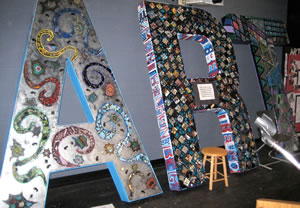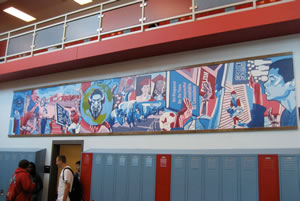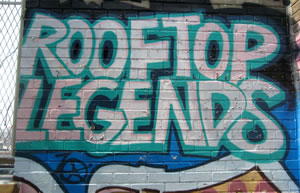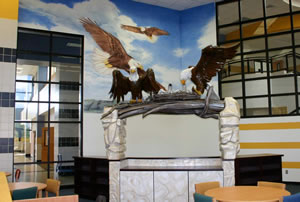Building Identity

PHOTOS BY SCOTT BERMAN
Carol Rogers, an art teacher at Belmont High School in Dayton, Ohio, stood in front of a grand mural depicting young people, uplifting activities and the school’s mascot, a bison, and placed the piece in perspective.
The colorful, permanent Renaissance Mural, created by a local artist and high schoolers and recently unveiled, is a signature feature of the building, yet there’s more to it. It’s also an example of how art can proclaim a building’s identity, while promoting educational goals at both a school and district level.
Belmont High, one of several high schools in this Ohio city, is a new building that opened for the 2011-2012 term, replacing a troubled old school that according to a local news report was “once the black eye of Dayton public schools.” For sure, art is just one facet of a comprehensive transformation that has taken place there, ranging from the new building itself, notable improvements in discipline and academic performance, teamwork between the administration and faculty, and a U.S. Department of Education School Improvement Grant.
Belmont, also armed with help from local businesses, has forged ahead with a vibrant art program. It’s a program that is activating students and beautifying the high school building, with key collaboration, creative vision and plenty of elbow grease from Dayton artist James Pate, who has worked with students on various pieces, including the flagship mural.
Educators at Belmont feel strongly that the school’s art program, which also includes two rotating galleries, reflects and fosters the new standards and spirit at this high school. Ken Kraemer, Belmont’s principal, says the key is to how to get students involved in activities that enable them to express themselves, such as art programs to beautify a school, and “be constructive and build pride in the building.”
The district has Stivers School for the Arts, as Rogers points out, yet “we need art everywhere…it’s uplifting, and there’s a direct correlation between academics and creativity; always has been.”

PHOTO BY SCOTT BERMAN
Art With a Purpose. The Renaissance Mural at Belmont High School in Dayton, Ohio, was created by a local artist and high school students and is a signature feature of the building. It also serves to promote educational goals at both a school and district level and can be credited in part for notable improvements in discipline, academic performance and teamwork between the administration and faculty.
Rogers led School Planning & Management recently on a tour of the new building and its art. She was bubbling with excitement. At one point, she showed off a stack of enormous metal letters donated from a defunct local drive-in cinema. It was a telling example of how enthusiastic outreach can work: the letters may eventually be mounted and lit to form what’s bound to be a distinctive marker for the new Belmont.
School art and beautification initiatives can take many forms. One provocative standout is the Graffiti Art program at New York City’s New Design High School. There, students work with teachers and professional graffiti artists in the school’s Rooftop Legends program to adorn an enormous rooftop space.
Broadly speaking, it’s important that students are an integral part of the process. “They really need to feel that this space is theirs,” says artist David McShane of the Philadelphia Mural Arts program, an active initiative with sponsors and partnerships, including businesses and community organizations, that is beautifying schools and other public and private buildings and spaces in that city.
McShane, who has been active in afterschool art programs and other activities for this initiative for eight years, explains that kids work with adults to create art such as positive themed murals for schools. These “colorful, amazing projects speak to the importance of a place and of students,” he explains, as well as providing a creative outlet.
Not only do young people need such a creative outlet, they are also tech-savvy and have high expectations for visuals. To resonate with young people, visuals need to be of high quality and, importantly, to stay fresh.
“The same old stuff gets stale,” is how Joel Griffin sees it. Griffin is owner of Graffixx, a Texas company that designs, creates and installs a range of art and graphics, such as murals, interior and exterior graphics and sculpted pieces, in schools and universities in several states.
The firm works on new or renovated buildings with a superintendent’s or principal’s office, as well as architects, general contractors, Parent-Teacher associations or athletic directors. Art and signage programs range very widely, and according to Griffin, it’s not unusual for costs to range from $2,000 for a limited project to as much as $90,000 for a comprehensive one in a new building.

PHOTO BY SCOTT BERMAN
Good Graffiti. The Graffiti Art program at New Design High School in New York City, where students work with teachers and professional graffiti artists in the school’s Rooftop Legends program to adorn an enormous rooftop space, “speaks to the importance of a place and of students,” as well as providing a creative outlet for these inner-city teens.
There have been changes afoot, note Griffin and his art director, Kerian Massey. About a decade ago, big, bold graphics, logos and the like, often on gym floors, predominated, explains Massey. She says that today, however, more schools are going for art and signage in places like cafeterias. There is a desire to present more of a “mall-look,” or what students are used to, in cafeterias, as well as, overall, and a broader notion to suggest a university-like appearance. Today, many schools are also interested in graphics with mottos and normative messages, particularly in libraries, Griffin notices.
A piece by Graffixx, a set of bold sculpted eagles in a nest, adorns Rogers Elementary School in Rogers, Texas, reflecting and promoting the district’s “eagle pride” motto. As Massey points out, “Typically, 40- to 60-year-olds decide what a school looks like.” The key, however, is to reach out to students who, she adds, want something “colorful and fun, not austere.”
As Griffin adds, “Graphics done well will enhance any environment if they’re done right.” Such lessons are not lost back at Belmont. When asked what the building art there signifies, Rogers doesn’t hesitate for a moment: “We’re alive. We’re learning. We’re reaching out. We’re part of the community.”
Suggestions about rejuvenating schools with art
Remember your target audience. To relate to students, consider artwork with “the wow factor; with pop and pizzazz,” says Graffixx’s Joel Griffin.

PHOTO BY SCOTT BERMAN
School Pride. The artwork of sculpted eagles in a nest, adorns Rogers Elementary School in Rogers, Texas, and reflects and promotes the district’s “eagle pride” motto. The art is one way the district is reaching out to the students in order to relate to them. The artists say you need to be successful, you must consider artwork with “the wow factor; with pop and pizzazz.”
Expect upgrades to graphics before too long. Art installed “25 years ago doesn’t cut it anymore,” says Griffin.
“Give freedom to your teachers to be creative. In my experience, they’ll run with it if you let them,” says Belmont Principal Ken Kraemer.
“Don’t get hung up on funding. Be resourceful,” says Belmont’s Carol Rogers.
Bear in mind that it’s about quality, not quantity. In other words, consider even a modest effort, says David McShane of the Philadelphia Mural Arts program. “It takes a few people willing to get it going and through to completion.”
Think through and reach out in terms of potential sponsorships, grants and funders.
Talk with your community and develop relationships — there are likely to be potential patrons and artists out there who are willing to donate materials, generate ideas, and help. They, in turn, may be able to provide further community outreach.
This article originally appeared in the School Planning & Management August 2013 issue of Spaces4Learning.